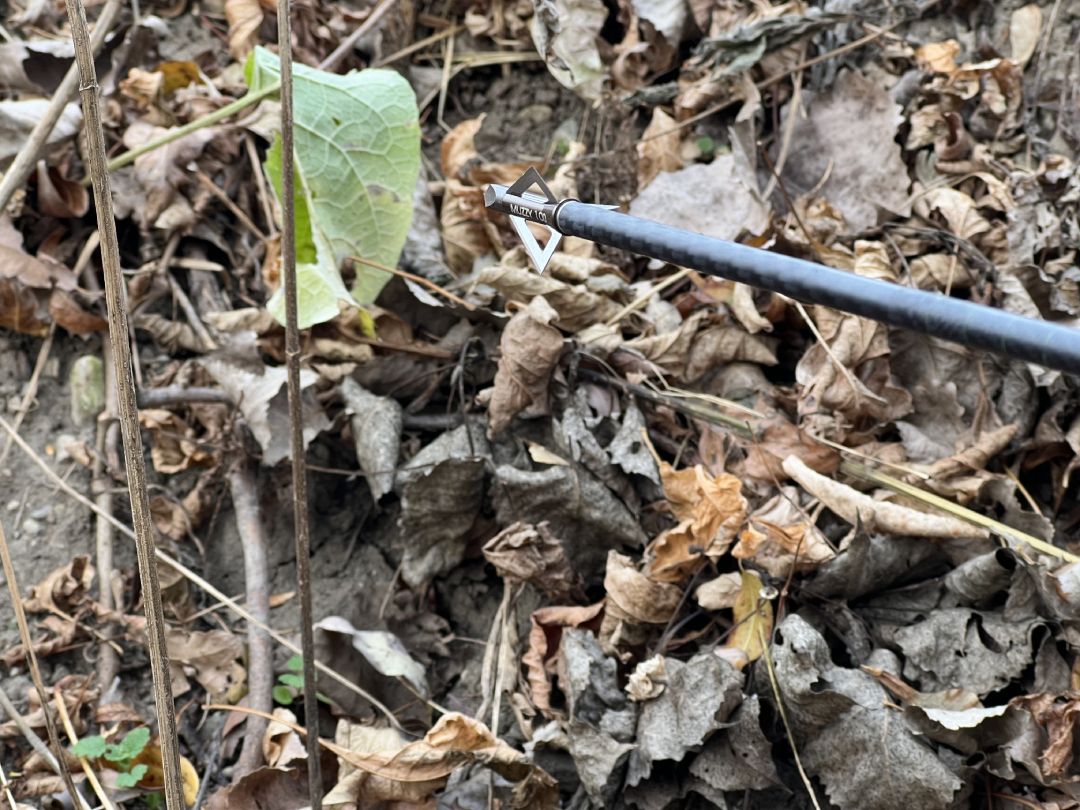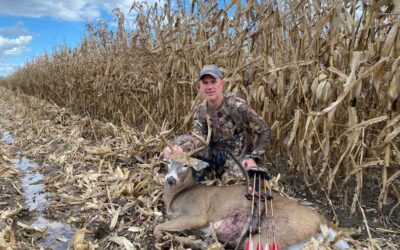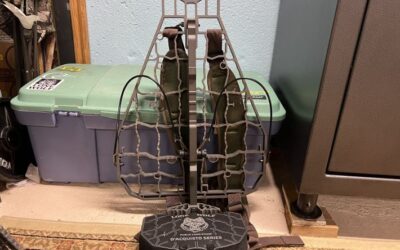This article may contain affiliate product links. I may receive a commission from sales. However, there is no extra cost to the buyer for using my affiliate link.
Using my affiliate links help support The Whitetail Teacher and allow me to deliver more content to help you become a better whitetail deer hunter.
Choosing the best deer hunting broadheads for bowhunting can be an overwhelming decision for a hunter. This article will present you with many options for the best deer-hunting broadheads on the market. (Both compound bows and crossbows)
My goal is to give you all the information that you need to make the best buying decision for the best broadheads to help you achieve a successful harvest. I will try my best to keep my bias out of this article except for the section about mechanical versus fixed blade broadheads after the product list.
1. Muzzy Fixed 3 Blade Broadheads
The Muzzy 3 Fixed Blade Broadheads are on the top of this list because it is by far my favorite broadhead to use for a large wound channel with reliability. They are made out of sharp stainless steel blades that get inserted into the broadhead. With a cutting diameter of 1 and 3/16 inches, you are sure to get a good amount of cutting without sacrificing wind friction. They also feature a trocar tip that creates deep penetration.
In 2022, I shot a doe and after looking at the damage, I found that this broadhead had no problem destroying the rib bone of the deer. The shot was from 30 yards with a bow set at 55 pounds. I would recommend these to any beginner or someone having trouble finding the right broadhead for them.
Pros:
- Replaceable blades
- Reduced wind friction
- Sharp as nails to cut through everything
- Made in the U.S.A.
Cons:
- Install yourself upon receiving broadheads
- Blades cannot be sharpened after use
2. Muzzy Tocar HBX Hybrid Broadheads
For those of you that like insurance, these broadheads are for you. The Muzzy Tocar HBX 4-blade broadheads have two fixed blades and 2 mechanical blades. They have stainless steel blades that ensure your blade sharpness will be unmatched. With the two fixed blades, you get 1 inch of cutting diameter. With the two mechanical blades, you get all the way up to 1 and ⅝ inches of cutting diameter. Muzzy makes some of the best types of broadhead for a compound bow.
These broadheads are a bit more expensive than the three fixed-blade muzzy broadheads but that should be no surprise with the number of blades and creative design. These also feature the Muzzy Trocar tip that will be able to smash right through large animals such as whitetail deer.
Pros:
- Great cutting diameter
- A hybrid between fixed and mechanical broadheads
- Quality product just like everything Muzzy makes
- Chisel tip for maximum penetration
Cons:
- Non-Replaceable
- Possible that they open before the shot
3. Rage Expandable Broadheads
Rage is known for its expandable broadheads and has created some of the best mechanical broadheads on the market today. These mechanical heads also have razor-sharp blades for better penetration and a better blood trail. They want to create an accurate shot just like your field tip by reducing the wind friction and keeping the broadhead compact in a closed position until the contact tip opens the main blade.
Upon impact, the Rage expandable blades have a cutting diameter of 2 inches. If you know that you want a mechanical broadhead, Rage offers the best choice for contact broadheads. Another great feature is their durability with a solid steel ferrule to hold the blades in a solid piece.
Pros:
- Reusable
- Large cutting diameter
- Accuracy levels
Cons:
- Risk of not opening
4. Rage Extreme 4 blade
The Rage Extreme 4-blade broadheads have a unique and cool design. They mix the idea of an Indian-style broadhead with the classic rage mechanical broadheads. With the fixed broadhead at the front of the broadhead and the two mechanical blades closer to the arrow shaft. They feature a crazy cutting diameter of 3.1 inches.
The biggest problem I have with these broadheads is the price. For a pretty penny, you only get two broadheads which are not enough to dial in your arrows with broadheads. I also think that the design has the possibility of not shooting as straight because of the top of the broadhead. The damage that will be done if you shoot a deer with this broadhead will lead to game animals’ significant damage to the vital organs.
Pros:
- Cutting Diameter
- Unique design
Cons:
- Price
5. Dead Ringer
Next on the list of broadheads is the Dead Ringer mechanical broadhead. These broadheads have an impressive 2 and ¾ inches of cutting diameter. The blades are held in the steel ferrule by a rubber band. However, I do not like the design of these broadheads because they look like they may prematurely open before impact. All that hold the blades in is a rubber band ring. That ring then moves back on impact and opens the blades.
These broadheads are specifically designed for high-speed bows and crossbows. They are great for those shots that do not hit a deer in the best spot. They will expand to make up for the misplacement. I would never use these broadheads because there are too many things that could go wrong and I do not shoot a specifically high-speed bow. Nevertheless, the Dead Ringer broadhead is one of the best crossbow broadheads that you will find for the price.
Pros:
- Cutting Diameter
- Flight Characteristics
Cons:
- Risk of opening prematurely
- Only for high-speed bows
6. Ramcat Pivoting Broadheads
The Ramcat Pivoting Broadheads have a great design with little bowls cut into the tip to reduce kinetic energy and increase potential energy for the entry of the broadhead into the deer hunter’s target. This is an important factor because it allows them to be extremely accurate and save energy. They feature a 1 and ¾ inch cutting diameter for a great blood trail. They are called pivoting broadheads which allow for the arrow to pivot as needed on impact to ensure the best blade angle entry possible. The blades seem to not fly as true when using a crossbow.
So if you are a crossbow user, I would suggest a different broadhead. The blades are also made of stainless steel and are extremely sharp. The blades are quite close to the riser of a bow and may interfere. Just make sure you have some wiggle room on your arrow before buying these broadheads.
Pros:
- Pivoting Technology
- Deep Bowls that reduce wind misdirection
Cons:
- Blades head towards the riser
- Big screws on the broadhead
7. G5 Megameat
The G5 Megameat is a mechanical blade broadhead that has an impressive 2-inch cutting diameter. These broadheads leave huge holes in deer and will give you a great blood trail if one is needed at all. The price is a bit high for 3 broadheads. They do have the option to replace used blades after use. Some bow hunters said that the blades were a little thin for them but they were still razor-sharp. I have always found that G5 makes quality broadheads and never fails to deliver what you need on your next hunt.
Pros:
- Replaceable
- Cutting diameter
Cons:
- Blades are a little thin
8. G5 Outdoors Montec
The G5 Montec is a classic broadhead that will never disappoint as long as properly taken care of. These broadheads do not have replaceable blades. This is a one-piece design with a fixed head. The blades are able to be resharpened after any use with a stone. This allows them to stay extremely sharp. The flight of these broadheads is extremely close to field points but may take a little bit to tune (just like every other broadhead).
I like these because of their simplistic design and reusability. They only have a cutting diameter of 1 and 1/16 inches. They also have a triangular tip that leads into the three blades.
Pros:
- Reusable
- Sharp
- Simple
Cons:
- Smaller cutting diameter
9. Slick Trick Broadheads
The Slick Trick broadheads need to be assembled out of the packaging. However, assembly is fairly easy. The design of this broadhead has some extra room towards the front of the broadhead. This gives it a better flight trajectory which is closer to that of a field point. It offers 1 and ¼ inches of cutting diameter. This broadhead is not my first choice but will surely get the job done.
Pros:
- Design
- Replaceable blades
Cons:
- Assembly required
10. Grim Reaper Broadheads
The Grim Reaper broadhead is a mechanical blade broadhead that has an interesting design. They have the blades significantly far back on the broadhead when they deploy. The other interesting and unique part of this broadhead is that the blades are designed to fold back in if it is not a clean pass-through. They do this to allow the arrow to get out of the deer and the blood to start flowing out of the deer.
I would not like this design because as a broadhead is still inside a deer, it can do more damage if the blades stay in a cutting position. This may lead to less blood loss but it may also be the difference between a liver shot and the broadhead cutting the lungs as well.
Pros:
- Cutting diameter
- Flys true to field points
Cons:
- Blades fold back up
- Price
11. Killer Instinct
The Killer Instinct broadheads feature sleek mechanical style blades that open on impact. I will say that the design of these broadheads is similar to a field point which aids in accuracy and performance. Upon the opening of the blade, the shape almost looks like the letter U which is a bit different. It also has a cutting diameter of 1 and a half inches. These broadheads are designed for high-speed bows such as crossbows.
Pros:
- Sleek design
Cons:
- Smaller cutting diameter
12. Magnus Killer Stinger
The Magnus Killer Stinger Broadheads are old-style broadheads. They are one piece that forms a triangle. There are also two small blades on the main part of the broadhead that is there for extra cutting power. You can reuse these broadheads if you would like or you can get replacement blades as well. The cutting diameter is 2 and ⅛ inches. I like this mix of a two-blade broadhead and a 4 blade broadhead because it gives you extra confidence that your shot will do as much damage as possible.
Pros:
- Cutting Diameter
- Will never fail to cut
Cons:
- Wind friction
13. Magnus 4 blade
The Magnus 4 Blade broadhead is a beautiful mix of the muzzy 3-blade broadheads and the Magnus Killer Stinger. It is designed with holes in the middle of the blade to reduce the amount of wind friction and still has two small blades on the main part of the broadhead. This allows for great accuracy without compromising cutting efficiency. The other major benefit to these blades is that they are thick and will be able to be re-sharpened.
Pros:
- Thick Blades
- Design features
Cons:
- Price
At the end of the day, each of these broadheads will be able to do the trick if they operate properly and you make a good lethal shot. It comes down to a personal preference decision once you have decided what will work best for you. Me, I currently shoot the Muzzy 3 Blade Fixed broadheads.
However, I would like to try a few other broadheads such as the Muzzy Tocar HBX, Magnus 4 Blade, and the G5 Montec. All these options are a quality broadheads that will work with your bow setups with some tuning.
How to Choose the Best Deer Hunting Broadhead for You
When you are looking to make the best buying decision for you, you want to take many aspects into consideration. As I talk about the different aspects of the best deer hunting broadheads, think about the aspects that you need in a broadhead.
Flight
The flight of a broadhead can be severely different than the flight of a field point. There are many different ways that an arrow can fly off.
But when it comes to the flight of different broadheads, you want to look at the amount of air that will be affecting the trajectory of the arrow. For instance, a blade that has no way of ventilating air may be more affected by wind conditions. The less air resistance that you have, the more consistent your broadhead will fly.
Weight will also play a factor in the flight of your arrow with a broadhead. But, I will talk more about the weight of broadheads in another section.
Click Here to learn more about arrow flight
Penetration
The penetration of a broadhead will have a huge effect on the blood trail. With more penetration the better the odds of having a good blood trail to successfully recover your harvest. If the arrow gets stuck in the larger game, it will have significantly less blood than a pass-through shot.
The surface area and weight of the broadhead will affect the penetration. The more surface area increases (amount of blades) the amount of friction during the flight and while passing through the deer will also increase. The heavier broadhead will penetrate farther with the same number of blades, but the trajectory will dip farther at longer ranges.
I like to find a happy medium between weight and surface when thinking about the penetration of my broadheads.
Cutting Diameter
In theory, the bigger the cutting diameter the better broadhead. Right? Not necessarily.
The cutting diameter does need to be big enough to make a significant entrance and exit wound on the deer. However, too big of a cutting diameter can hinder the amount of penetration through the deer causing no exit wound. Too small of cutting diameter and you risk not clipping one of the vitals creating an ethical shot.
Weight
The weight of your broadhead will directly affect the flight of your arrow and the penetration. The heavier the broadhead – and entire arrow build – the more it will drop at longer distances. A heavier broadhead will penetrate farther into a deer but the long shots will be much more difficult to make. Most fixed broadheads and mechanical broadheads are weighted at 100 grains or 150 grains.
Personally, I shoot 100-grain broadheads because they are the exact weight of my field points. This makes it much easier to broadhead-tune my arrows when hunting season rolls around.
Click Here to learn more about the weight of an arrow
Materials
The materials that make up the broadhead are a minor factor in your ability to make an ethical shot on a whitetail deer. However, the materials of the broadhead start to play a factor in the ability to cut through the deer’s ribs and shoulder blades and reusability.
I like to use razor blades that are thinner but extremely sharp. I do have to replace the blades after a successful harvest. My dad, on the other hand, likes a fixed-blade broadhead that only has two blades. He can resharpen the edges of his broadheads after every successful harvest.
It all depends on how you want to replace the broadheads after shooting a whitetail deer. I would also say stick to stainless steel blades because that is the best material for a sharp and durable broadhead. The thickness of the broadhead of your choice depends on how you would like to replace your broadheads.

Mechanical Blade Broadheads V. Fixed Blade Broadheads
The debate between mechanical and fixed blade broadheads is a hot topic currently. I do not think that the debate will be resolved anytime soon and that is perfectly fine. With many options for broadheads, you will be able to test out different types for yourself.
Mechanical Blade Broadheads
A mechanical blade broadhead is a broadhead that will expand on impact with a deer. It should be noted that if you have a lower draw weight, you will be using energy to expand the blades which can negatively affect your penetration.
Pros: Fly more like a field point, Wider cutting diameter (usually), Open on impact
Cons: Risk of the broadhead not opening at all, A close shot and it may not open all the way before exiting
Fixed Blade Broadheads
A fixed blade broadhead is one that does not have any moving parts.
If you have a lower draw weight, a fixed blade broadhead will be the most beneficial because you save all your energy for penetration.
Pros: No risk of losing cutting diameter, Best for beginners
Cons: Less cutting diameter (Usually), Fly more differently than field points in comparison to mechanical blade broadheads.
Personal Opinion
I find that I like fixed-blade broadheads better than mechanical-blade broadheads. For me, there is too much risk of the blades not opening on impact. It takes such a small amount of time to sight in a fixed blade broadhead. You also are not losing that much in cutting capabilities by going with a fixed blade over a mechanical blade.
That is why I shoot fixed blades. However, I encourage anyone who doesn’t know what blade is right for you to try them out in the off-season.
Conclusion of the Best Broadheads for Deer Hunting
The best deer hunting broadheads are a piece of equipment that is vitally important to a successful hunt. However, at the end of the day, it is about personal preference. Each broadhead on this list will definitely be able to ethically harvest a deer. Whether you like mechanical or fixed-blade broadheads, it is important to go with the broadhead that you feel most comfortable with on your arrows.
You may also be interested in a free E-book to help you create a personal hunting game plan, Free PDF that explains the 5 most important fundamentals for whitetail deer hunting, A Free Fut Calendar Guide, Or All Three Free Options
Thank you for visiting The Whitetail Teacher! If you enjoyed this post, make sure to share it with a friend.
If you have any questions or recommendations for new blog posts, please use the contact form.
Learn, Plan, Execute,
The Whitetail Teacher




